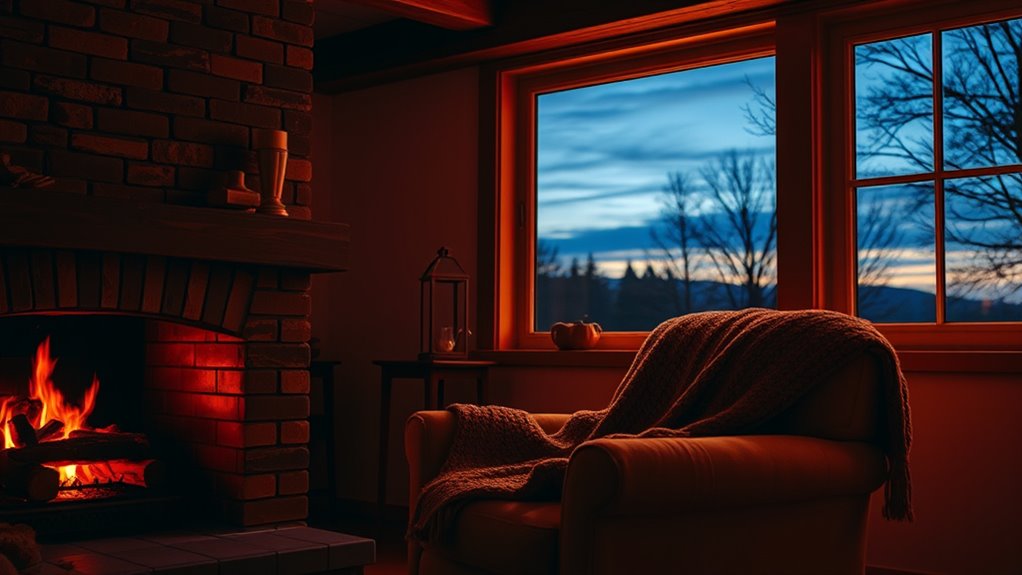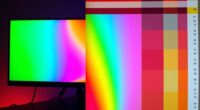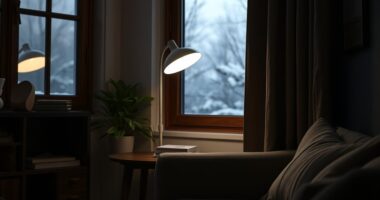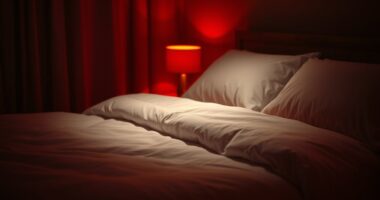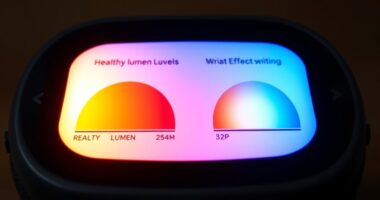Your mood is deeply affected by color temperature—warm light creates comfort, relaxation, and a sense of safety, while cool, blue light boosts alertness and focus. Properly measuring and calibrating your lighting can help you harness these effects, supporting relaxation or productivity when needed. Natural sunlight influences mood positively, and artificial lighting can improve well-being with smart adjustments. Keep exploring to discover how tweaking your environment’s light can transform your daily mood and mental clarity.
Key Takeaways
- Warm lighting fosters relaxation, comfort, and emotional stability, creating a calming environment that reduces stress.
- Cooler, blue-rich light enhances alertness, focus, and productivity, boosting mood during work or study.
- Proper color temperature can regulate circadian rhythms, improving sleep quality and overall emotional well-being.
- Natural sunlight and warm artificial lighting increase serotonin levels, elevating mood and reducing symptoms of seasonal affective disorder.
- Technological innovations like smart lighting and light therapy devices optimize mood by adjusting color temperature to support mental health.
Understanding Color Temperature and Its Measurement
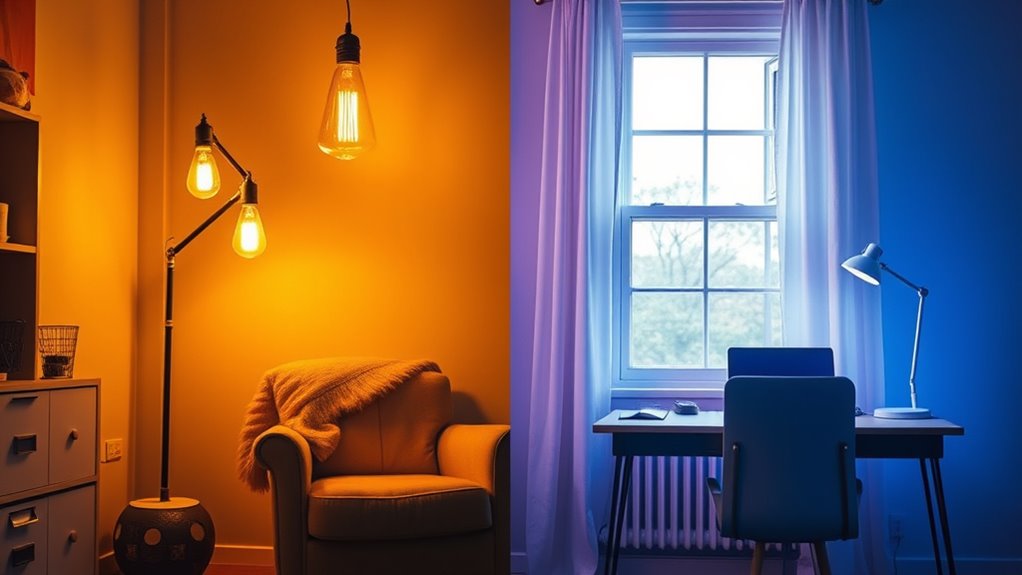
Have you ever wondered why some lighting feels warm and cozy while other lighting seems cool and clinical? It all comes down to color temperature, which is measured through color measurement techniques. This measurement helps determine whether light appears more yellowish, resembling sunlight at sunset, or bluish, like overcast skies. Light calibration guarantees that light sources emit a consistent color temperature, essential for creating the right atmosphere. By understanding how to measure and calibrate lighting, you can control the mood and ambiance in any space. Accurate color measurement allows you to select the appropriate lighting that aligns with your desired effect, whether warm and inviting or cool and sterile. Mastering these concepts helps you craft environments that influence feelings and behaviors effectively. Additionally, remote work environments benefit from proper lighting calibration to reduce eye strain and improve overall productivity.
The Psychological Effects of Warm Light
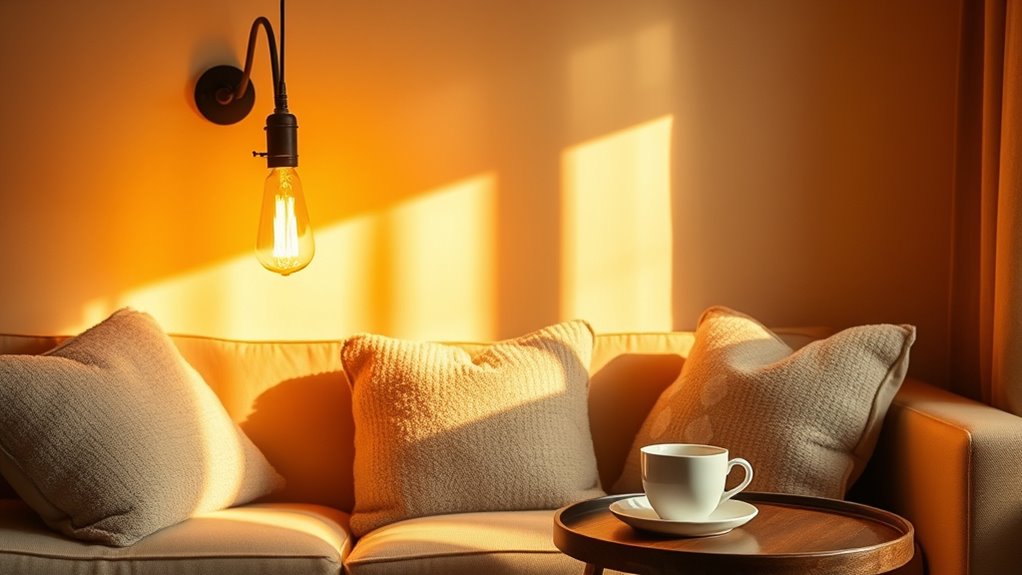
Warm light has a powerful influence on your mood and perception, often creating a sense of comfort and relaxation. It promotes psychological comfort by making your surroundings feel inviting and safe. This type of lighting also enhances emotional stability, helping you feel more grounded during stressful moments. Additionally, adaptive lighting technologies can optimize warmth and brightness to suit your mood and activities. Here are three ways warm light impacts you:
- It reduces stress, fostering a calming atmosphere.
- It encourages social interaction by making spaces feel intimate.
- It supports relaxation, aiding in better sleep and mental clarity.
How Cool Light Influences Alertness and Focus

Cool light enhances your alertness and focus by stimulating your brain and increasing your attention to detail. Blue light, a key component of cool lighting, signals your brain to stay awake and alert. This effect boosts concentration, making it ideal for work or study environments. The table below highlights how cool light impacts your mental state:
| Aspect | Effect | Benefit |
|---|---|---|
| Blue Light | Increases alertness | Keeps you awake and attentive |
| Cool Lighting | Enhances concentration | Improves focus during tasks |
| Visual Clarity | Sharpens focus on details | Boosts productivity |
| Mood Impact | Promotes wakefulness | Reduces fatigue |
The Impact of Natural Sunlight on Mood
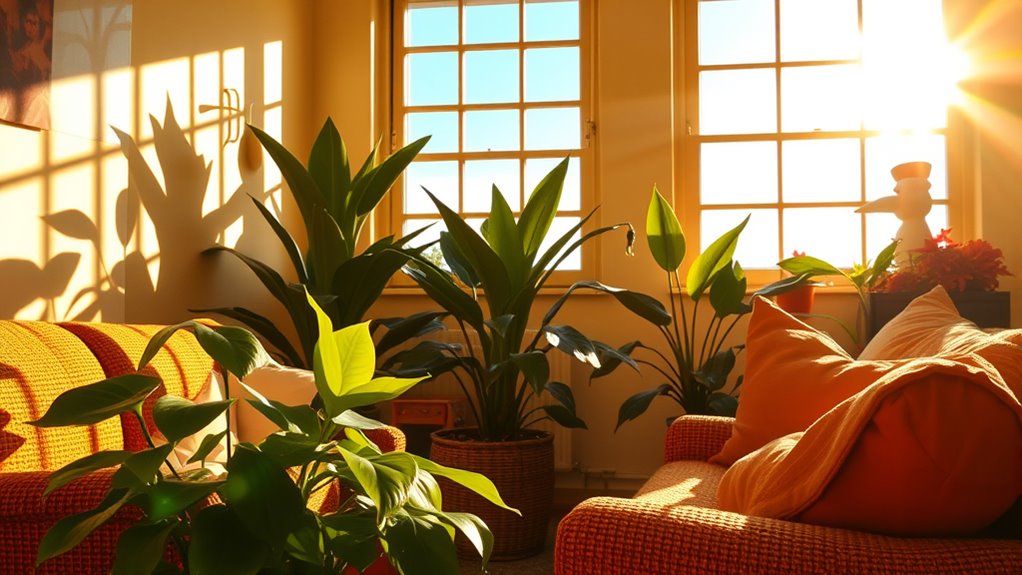
Natural sunlight plays an essential role in shaping your mood, influencing how energized and positive you feel throughout the day. Exposure to natural light offers several benefits, especially in combating seasonal affective disorder (SAD). Here are three ways sunlight impacts your mood:
Natural sunlight boosts mood, energy, and overall well-being throughout the day.
- It boosts your production of serotonin, helping you feel happier and more balanced.
- It enhances your sleep quality by regulating melatonin levels, reducing feelings of fatigue.
- It provides phototherapy benefits, which can alleviate symptoms of SAD during darker months.
- Consistent exposure to natural light can improve overall mental health by promoting mindfulness and emotional well-being.
Regular sunlight exposure helps prevent mood dips and supports overall mental well-being. If natural light is limited, considering light therapy can replicate these benefits, improving your mood and energy levels naturally.
Artificial Lighting and Its Role in Daily Well-Being
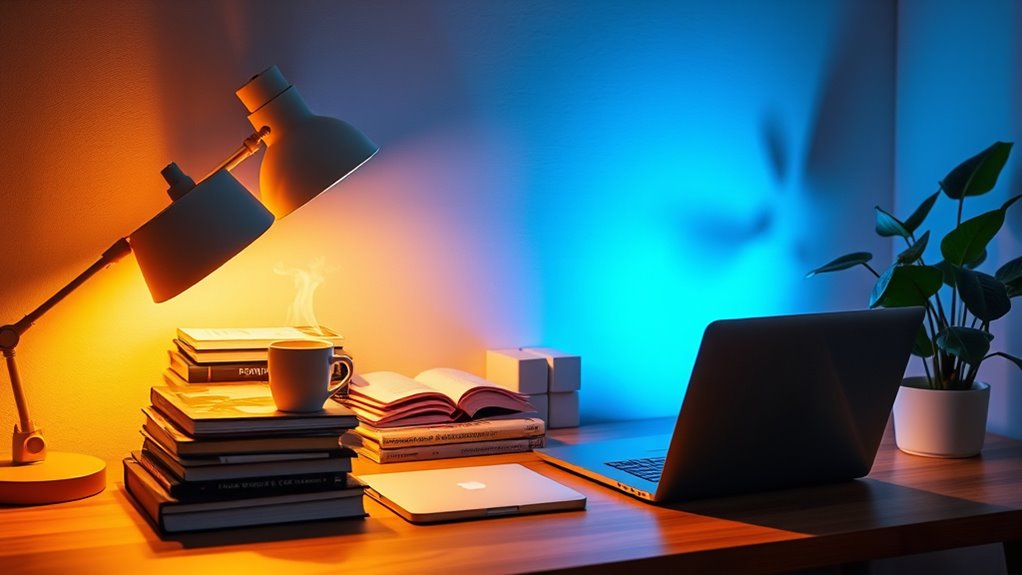
Artificial lighting influences your circadian rhythms and can affect your overall mood throughout the day. Choosing the right color temperature and timing can help boost your energy and improve sleep quality. Implementing smart lighting strategies allows you to enhance your well-being effortlessly. Additionally, understanding best colognes can complement your mood-boosting efforts by boosting confidence and personal presentation.
Impact on Circadian Rhythms
Since artificial lighting can substantially influence your body’s internal clock, it plays a crucial role in regulating your circadian rhythms. Bright, blue-rich light, especially in the evening, can cause:
- Melatonin suppression, making it harder to fall asleep.
- Disrupted circadian entrainment, leading to irregular sleep patterns.
- Reduced sleep quality and daytime alertness.
These effects occur because certain light wavelengths signal your brain to stay alert, delaying melatonin production. When your exposure to blue light is excessive at night, your circadian rhythm becomes misaligned, impacting overall well-being. Additionally, understanding family dynamics can help you better comprehend how personal environments influence sleep habits and mood. To maintain healthy rhythms, it’s essential to manage artificial lighting, especially during evening hours, and prioritize natural light exposure during the day. Proper lighting choices support your internal clock, enhancing sleep and daily functioning.
Mood Enhancement Strategies
Lighting plays an essential role in shaping your daily mood and overall well-being, as the right illumination can boost energy, improve focus, and foster a positive outlook. By understanding how color perception influences your emotions, you can optimize your environment to feel more balanced and motivated. Light therapy is a practical mood enhancement strategy, especially during darker months or for those with seasonal affective disorder. Using bright, full-spectrum lights mimics natural sunlight, helping regulate your body’s internal clock and elevating your mood. Adjusting color temperature in your lighting influences how you perceive your space and your feelings within it. Incorporating these techniques allows you to harness artificial lighting to support emotional health and create a more uplifting daily atmosphere. Additionally, choosing lighting that accommodates color temperature preferences can further enhance your emotional comfort and mental clarity throughout the day.
Practical Ways to Adjust Your Environment for Better Mood
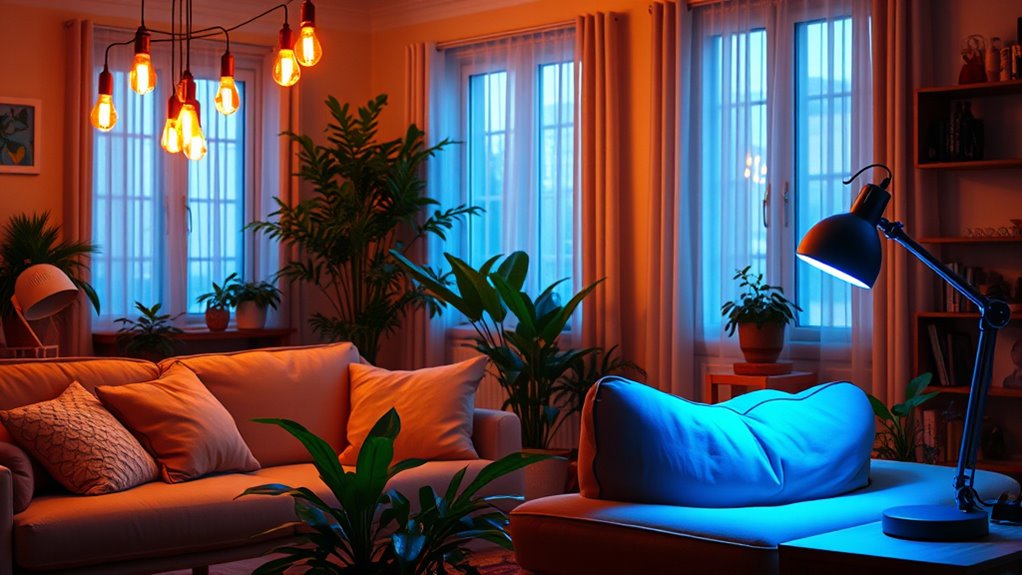
Adjusting your environment can considerably boost your mood by creating a space that feels welcoming and uplifting. Focus on color temperature regulation and mood specific lighting to influence your feelings positively. Here are practical steps: 1. Use warm light bulbs in common areas to promote relaxation and comfort. 2. Incorporate cool, bright lighting in workspaces to boost alertness and focus. 3. Invest in adjustable lighting options to switch between different color temperatures based on your mood or activity. Additionally, selecting lighting with specific color temperature can have a significant impact on your emotional state and overall well-being.
The Connection Between Color Temperature and Sleep Patterns

Your sleep quality can be influenced by the color temperature of your environment. Exposure to blue light before bed can suppress melatonin, making it harder to fall asleep, while warm lighting can promote rest. Understanding this connection helps you create a space that supports healthy sleep patterns. Additionally, selecting AI-driven solutions for personalized lighting adjustments can further optimize your sleep environment.
Blue Light and Melatonin
Since blue light exposure in the evening can interfere with your body’s production of melatonin, it plays a crucial role in regulating sleep patterns. Blue light, emitted by screens and artificial lighting, causes melatonin suppression, making it harder for you to fall asleep. To understand this better, consider these effects:
- Disrupts your circadian rhythm, delaying sleep onset.
- Reduces overall sleep quality, leading to fatigue.
- Impairs REM sleep, affecting memory and mood.
- Using professional equipment for lighting can help minimize blue light exposure during evening hours.
Warm Lighting and Rest
Exposure to blue light in the evening can interfere with melatonin production, making it harder to fall asleep. Instead, warm lighting creates a calming environment that promotes restful sleep. Using soft, amber hues during the night can help signal to your body that it’s time to wind down. Festive lighting, often featuring warm tones, can enhance relaxation without disrupting your sleep cycle. For those experiencing seasonal affective disorder, switching to warmer lighting during darker months can improve mood and reduce symptoms. Additionally, GMC tuning techniques can optimize vehicle performance, but just like proper lighting, they require careful adjustments to achieve the best results. By minimizing exposure to bright, cool lights in the evening and embracing warm lighting, you support your body’s natural rhythm. This simple change can lead to better sleep quality and a more balanced mood, especially during the shorter days of winter.
Innovative Technologies That Manipulate Light for Mental Health

Innovative technologies are now transforming how we manipulate light to support mental health. Advanced devices use adjustable color temperature and targeted light therapy to improve mood and well-being. Here are three key innovations:
- Smart lighting systems that adapt color temperature throughout the day, mimicking natural sunlight to boost alertness or relaxation.
- Light therapy devices designed to deliver precise wavelengths, combating Seasonal Affective Disorder and other mood-related issues.
- Wearable light therapy gadgets that provide personalized treatment, offering portability and convenience for ongoing mental health support.
These technologies allow you to harness the power of light in new ways, making it easier to optimize your environment for mental clarity, energy, and emotional balance.
Tips for Creating a Harmonious Lighting Atmosphere

Creating a harmonious lighting atmosphere begins with understanding how different light qualities influence your mood and environment. To do this, pay attention to color perception, which is shaped by the light spectrum emitted by your lighting sources. Opt for warm tones in relaxing areas to promote calmness, while cooler tones can energize spaces like workstations. Blend various light sources to create layers of illumination, ensuring a balanced ambiance. Use dimmers to adjust brightness and fine-tune the atmosphere according to your needs. Additionally, consider the placement of lights to avoid harsh shadows or overly bright spots. By thoughtfully selecting your light spectrum and paying attention to color perception, you can craft a space that feels both harmonious and supportive of your mood.
Frequently Asked Questions
Can Color Temperature Changes Improve Mental Health Over Time?
Changing color temperature can positively impact your mental health over time. Warmer lighting encourages emotional regulation, helping you feel calmer and more centered. Cooler light, especially in the evening, can improve sleep quality by signaling your body it’s time to wind down. By adjusting your environment’s color temperature thoughtfully, you support better emotional balance and restorative sleep, both of which are essential for long-term mental well-being.
How Does Color Temperature Affect Productivity in Work Environments?
You’ll find that lighting design and visual perception directly influence your productivity at work. Bright, cool color temperatures promote alertness and focus, helping you stay engaged. Conversely, warmer tones create a relaxing atmosphere, which might reduce efficiency. By adjusting the color temperature of your environment’s lighting, you can optimize visual perception, boost concentration, and enhance overall work performance, making your space more conducive to productivity.
Are There Specific Color Temperatures Recommended for Relaxation?
For relaxation, you should opt for warmer color temperatures, around 2700K to 3000K, which promote calmness and comfort. Lighting psychology shows that softer, warmer lights help reduce stress and create a cozy atmosphere. In color therapy, warm hues are linked to relaxation and emotional balance. So, choosing warm lighting can markedly enhance your mood, making your space feel more inviting and peaceful.
Can Adjusting Light Color Temperature Help With Seasonal Affective Disorder?
Imagine your mood as a delicate dance, guided by the glow of light. Adjusting your light color temperature can be like tuning an instrument for better harmony, especially during darker months. Light therapy with warmer hues helps regulate your mood, battling seasonal affective disorder. By shifting the light’s warmth, you create a brighter stage for mood regulation, making winter days feel a little less gray and a lot more uplifting.
What Are the Best Color Temperatures for Different Household Activities?
When considering lighting design for your home, the best color temperatures depend on your activity. For tasks like reading or cooking, opt for brighter, cooler lights around 4000-5000K, which promote alertness. For relaxing or winding down, warmer tones around 2700-3000K create a cozy atmosphere. Understanding color psychology helps you choose lighting that supports your mood and enhances each space effectively.
Conclusion
By paying gentle attention to the colors that surround you, you can subtly guide your mood and well-being. Small adjustments in lighting might seem minor, but they hold the quiet power to brighten your days and soothe your nights. Embrace these subtle shifts, and let the natural harmony of light help you find balance and calm in everyday moments. Sometimes, the softest changes reveal the deepest peace you seek.
